SGS检验员新员工现场作业规程(中英文对照)要点
- 格式:pdf
- 大小:479.22 KB
- 文档页数:24
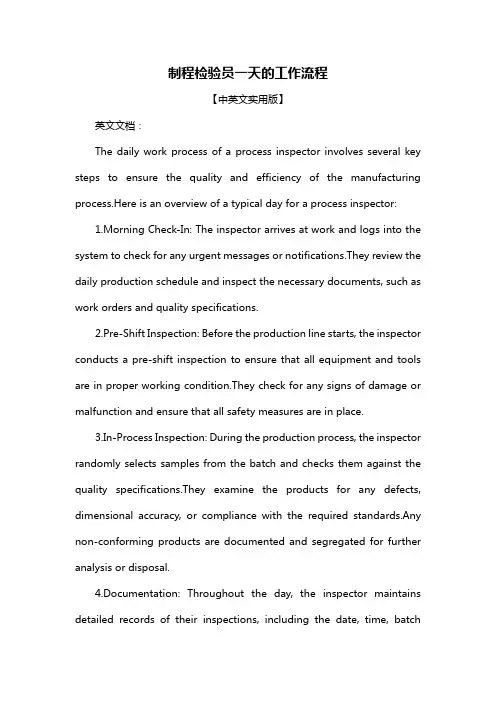
制程检验员一天的工作流程【中英文实用版】英文文档:The daily work process of a process inspector involves several key steps to ensure the quality and efficiency of the manufacturing process.Here is an overview of a typical day for a process inspector:1.Morning Check-In: The inspector arrives at work and logs into the system to check for any urgent messages or notifications.They review the daily production schedule and inspect the necessary documents, such as work orders and quality specifications.2.Pre-Shift Inspection: Before the production line starts, the inspector conducts a pre-shift inspection to ensure that all equipment and tools are in proper working condition.They check for any signs of damage or malfunction and ensure that all safety measures are in place.3.In-Process Inspection: During the production process, the inspector randomly selects samples from the batch and checks them against the quality specifications.They examine the products for any defects, dimensional accuracy, or compliance with the required standards.Any non-conforming products are documented and segregated for further analysis or disposal.4.Documentation: Throughout the day, the inspector maintains detailed records of their inspections, including the date, time, batchnumber, and any issues identified.They also document any corrective actions taken or communicated to the production team.5.Collaboration with Production Team: The inspector works closely with the production team to address any quality-related concerns or issues.They provide feedback, suggest improvements, and collaborate on resolving any production bottlenecks or defects.6.Lunch Break: The inspector takes a scheduled lunch break to relax and recharge.They return to work promptly after the break to continue their duties.7.Final Inspection: Before the end of the shift, the inspector conductsa final inspection to ensure that the production batch meets the required quality standards.They check the final output against the production records and specifications.8.Shift Handover: The inspector completes a handover report, summarizing the day"s activities, inspections, and any issues encountered.They communicate this information to the incoming inspector or supervisor to ensure a smooth transition.9.Cleaning and Maintenance: Before leaving for the day, the inspector ensures that the inspection area is clean and organized.They also perform routine maintenance on inspection tools and equipment, as necessary.10.Evaluation and Continuous Improvement: At the end of the day,the inspector reflects on their work and identifies areas for improvement.They may participate in training sessions or meetings to enhance their skills and knowledge.In conclusion, a process inspector"s daily work process involves various steps to maintain quality standards and ensure efficient production.Their role is crucial in identifying and addressing any issues promptly, contributing to the overall success of the manufacturing operation.中文文档:制程检验员的一天工作流程包括多个关键步骤,以确保生产过程的质量和效率。
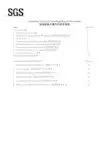
Attending Surveyor Handling/Report Procedure现场检验员操作和报告规程Index Page No.1.Scope 范围 22.Draft Survey 水尺计重 23. Weighing or random/check Weighing衡重和随机/抽检重量 44. Tally理货 65. Supervision of container unloading 集装箱的监卸 66. Supervision of the vessel discharging船舶的监卸 77. Supervision of container stuffing集装箱的监装 88. Supervision of the vessel loading船舶的监装 99. Manual sampling人工取样 1110. Sample preparation制样 14 Attached document附相关表格Page No.1.Moisture Determination Record. 测量水份计算表 322.Outturn weight. 按每批加权平均计算表 333.ISO standard Scoop. ISO标准取制样铲尺寸 344.International Sieve. 国际标准筛网对照表 355.Calculation of Proportion. 明金属比例计算表 376.Melting of Metallic Material Record. 金属熔锭重量记录 381. Scope 范围-This procedure specifies how to report to the handling office when attending surveyors are performing the inspection at the location of the inspection. The main job is including daily report and Final Inspection Report after completion of the inspection.这个规程是现场检验员在现场如何操作和报告给办公室, 主要工作是包括汇报每天的工作进展和检验完毕后递交最终检验报告.-The inspectors should carefully read the work instruction and know inspection scope in details before to perform the inspection.在检验工作之前, 检验员必须认真, 仔细阅读工作指令单上的具体内容和明确知道检验工作的内容.-Attending surveyor should prepare all related the equipments and documents in accordance with work instruction.检验员必须按工作指令单的内容准备相关工具和资料.- During inspection, attending surveyors should report irregular situation if have at thelocation of the inspection to handling office (handling T/C for this file, section head or line manger) on the time.检验过程中, 现场检验员如发现一切异常情况必须在现场第一时间报告办公室具体负责的协调员, 主管或操作经理.-Daily report should be sent handling office before noon time of the working day or phone call to report in details if attending surveyors have no enough times to prepare when inspection is started.现场检验员每天中午前报告工作进展, 如没时间写报告可以电话通知.-Final inspection report should be prepared by attending surveyor within 24 hours after completion of the inspection and sent to handling office on time including photos.最终检验报告和现场照片必须在检验工作完成后24小时交办公室.2. Draft Survey 水尺计重The total discharged or loaded quantity should be determined by initial and final draft survey in accordance with the vessel displacement in attendance of the SGS surveyor, localCIQ/CCIC surveyor, vessel chief officer and other relevant parties.SGS检验员, 本地商检局/商检公司, 船舶大副或其他检验机构对根据船舶轻, 重排水量计算出装, 卸货物的重量.The survey must be conducted meticulously, taking into account all the prevailing circumstances. The draft survey consist of the “initial” and “final” surveys, which determine, by measurement, calculation of the vessel’s displacement before and after loading or discharging. The difference between these two displacements is the weight of cargo discharged/loaded.现场检验员根据现场情况, 必须一丝不苟对船舶的初始和最终船舶状态进行观察, 测量和计算得出装卸货的重量.2.1 Equipment used for draft survey 水尺计重通常使用的工具:- A certified draft survey hydrometer.检测合格的密度计.-Calibrated sounding tape.检测合格的量水尺.-Water finding paste.量水膏.- A powerful hand torch or flash light for draft reading at night time if possible.可能的话备照明灯或手电以备夜间用.-Calculator / computer.计算器或计算机.2.2 In initial draft survey在做初水尺注意事项:-Identify the vessel and confirm the cargo quantity of Bill of Lading.与船方确认装船数量和卸货提单重量.-Obtain the vessel constant at loading port or previous voyage from vessel chief officer and report to the handing office on time if it is any discrepancy when you found.与船方了解装港或前几个航次船舶常数. 如与初尺结果差异很大应立即报告办公室. -Obtain the copy of the ship’s particular, cargo stowage plan, bilge water tank record of voyage. Proposed discharging/loading sequence and other required documents if any.须船方复印船舶规范, 积载/配载图, 本航次污水仓记录, 装/卸货次序和其他相关文件. -Identify the position and name of all deductible liquid tanks from chief officer.要求船方大付提供所有压载水舱/淡水舱名字和位置.-Identify the displacement table, ballast water sounding table of the vessel and confirm that it is within the period of validity.确认船舶排水量表, 压载水舱和谈水舱表是否有效.-Copy, record and photo the main data of displacement table at one meter intervals if possible.可能的话复印或拍照船舶排水量表上平均吃水上下一米的主要数据.-Others if any 如有其他注意事项.2.3 Conduct draft survey 水尺计重过程:-Read the draft mark at six (6) side of vessel’s in attendance of SGS surveyor, chief officer, Local CIQ/CCIC surveyor and other relevant parties if any. Record the draft readingfigures.SGS检验员, 船方大付, 本地商检局/商检公司或有关检验机构观察船舶六面吃水并记录.-Sounding of all the ballast tanks and fresh water tanks using a calibrated sounding tape.Record the original figure in deductible weights.用检测合格的量水尺对所有压载水舱, 淡水舱测深. 记录原始的扣除重量.-Collect a representative sea water sample which was from half deep of the quarter mean draft to record the density using a calibrated hydrometer.提取位于一半平均吃水, 具代表水样, 用检测合格的密度计测量密度.-As a general rule, the quantity of fuel oil, diesel and lubricating oil is to be provided by chief engineer of vessel without further verification.通常用船方轮机长提供的轻, 重燃油数量来计算.-Calculation is based on the provided hydrostatic tables.用船方提供的排水量表进行计算.-Release the draft survey report to the vessel for their confirmation after final draft survey.水尺计重结束后出具水尺报告交于船方确认.-Report to the handling office including the draft survey report, etc.报告给办公室包括水尺报告等资料.-Others if any如有其他注意事项.Note: Sea condition of the draft reading in initial and final should be well and normal less than 30 cm on the water surface.注意: 初/末看水吃时, 通常水面波动应小于30厘米.3. Weighing or random/check Weighing衡重和随机/抽检重量.-Used weigh-bridge or scale for weighing should be calibrated within the period of validity.Copy or to take the photos of the calibration certificate of the weigh-bridge or scale.所用衡重地磅和秤必须检测合格并在有效期内. 复印或对检测合格证拍照.-Before using, checked the weigh-bridge or scale working condition (use standard test weights if available)可能的话, 衡重前用标准砝码对磅称进行校验.-Adjust the weigh-bridge or scale in zero and then make sure itself is in level condition, clean.衡重用磅秤须校正零位使之处于良好工作状态, 清洁干净.-Record the type, brand and producer of the weigh-bridge or scale.记录所用衡重磅秤的型号, 规格和生产厂家.-For trucks/railway wagons weighing should be weighed across same time, for gross and tare. Record all weight figures, trucks/railway wagons number and times.卡车和火车皮衡重时, 须计录轻/重车, 衡重时间, 重量结果和车号.-Railway wagons should not be weighed on the trot (while moving).火车皮衡重时须出静态结果.-It is recommended that the driver should be out of the motor cabin on each weighing operation.每次卡车衡重时, 司机须离开驾驶室.-For jumbo bags weighing, considering the carried material in tare weight such as handing sling, wooden pallet, W.P.P jumbo bag or others.吨袋衡重时, 须考虑提吨袋索具的重量如吊索, 木托板, 吨袋和其他物品.-Supervision of weighing whole process and record all weighing results on weight list.全程监督衡重全部过程并记录重量结果.-Take the pictures during the whole process, showing:整个过程须拍照, 通常显示:View of the weighing place which is including weighbridge or scale.衡重磅秤的地点.Zero adjustment of the weigh-bridge or scale.衡重磅秤零位的矫正.Package/truck of the cargo weighed on weigh-bridge or scale (show the reading on the picture if possible).可能的话照片应显示衡重时车载的货物, 包装.Note: Random or check weighing only used for constant weight of the package. If the weight of the package is more or less the 0.2 % – 0.3 %, can not be calculated the total cargo weight base on random or check weighing figure.注意: 随机/抽检重量仅适用于定量重的包装货物. 如包装货物的重量差大于0. 2% - 0.3 % 本身重量. 本方法不能用于根据随机/抽检重量来推算出整票货的重量.-Others if any.如有其他注意事项.4. Tally理货-Tally means to account the No. of the package of the cargo during movement - Loading and discharging of the vessel, stuffing and unloading of the container, etc.理货是指包装货物在货物移动过程中(如船舶的装/卸和集装箱的装/卸)点数.- Recorded the No. of the package per shifting per cargo holds for the vessel, container No., size, type for container stuffing or unloading.应记录船舶的装/卸货物过程中每舱口, 每工班的件数. 集装箱装/卸应记录箱号, 尺寸和箱型.- Copy or take the photos for COSTACO certificate, tally report, daily sheets per shifting on the time if possible during vessel loading and discharging.复印或对理货证明, 理货报告拍照. 在船舶的装/卸货物过程中及时拿到理货日报表并记录.-Others if any.如有其他事项.5. Supervision of container unloading 集装箱的监卸-Before container opening, take the pictures for full sealed container, check the container condition, record the container No., size, type and seal No.开箱前, 须对加封集装箱拍照, 检查集装箱外观状况, 记录箱号, 尺寸和封号.-Take the photos when opened the container door before unloading.开箱后, 卸货前须对集装箱拍照.-Account the No. of the package of the cargo during container unloading and take the pictures in half discharged container.卸货中清点卸货包数并对卸完半箱货集装箱拍照.-Take the photos after completion of the discharging in empty container, also closed one right side door which was including container No.卸货完后对空箱拍照并对关上右门(显示箱号的门)拍照.-Record the No. of the package and take the photos for the damaged the cargo in container if any.记录卸货过程中如有残损货物, 并对残损货物在箱内的情况拍照.-After container unloading, all cargo should be inspected. Our surveyor should check packing, marking, cargo condition (Heat / Batch / Lot / Production No.), Logo etc, also take the photos for the cargo.货物卸完后, 对货物进行检验/检查/记录-包括货物的包装, 唛头, 货物状况(炉号, 批号和生产编号), 标志等.-Others if any.如有其他注意事项.6. Supervision of the vessel discharging船舶的监卸6.1 Vessel time Log记录船舶在港时间:-Vessel arrive anchorage船舶抵锚地时间.-Pilot on board ( P.O.B) 引水员上船时间.-First line ashore第一根缆绳上岸时间.-All fast and secured the Pier No.靠妥码头泊位时间.-Clean Custom边防/检验检疫通过时间.-Initial draft survey if any做初水尺时间.-Open hatches开舱盖时间.-Commence discharging开始卸货时间.-Weighing commenced if any开始衡重时间.-Completed discharging卸完货时间.-Weighing completed if any衡重完毕时间.-Final draft survey if any做末水尺时间.-Estimated time of departure (ETD) or sailing time预计离港/开航时间.- Record weather condition during whole discharging operation prior记录整个卸货过程的天气现象.-Others if any如有其他注意事项.6.2 Copy of related documents from the vessel从船方复印相关资料:-Copy of the vessel particular船舶规范-Copy of the Cargo plan积载图-Copy of manifest or Bill of lading if any舱(关)单和提单-Copy of the tally sheet for the package material only if any对包装货的理货资料.-Copy of the Notice of Readiness if any (N.O.R)装卸就绪通知书.-Copy of the Statement of Fact (S.O.F)船舶在港事实记录-Others if any如有其他注意事项.6.3 Discharging operation卸货过程:-Number of the cargo holds to store the material.几个货舱堆积所卸的货.-The cargo stowed condition before discharging and cargo condition during discharging.卸货前货物的堆积状况和卸货过程中的货物状况.-If the cargo is gone to be directly discharged to the opening area at the pier, the quayside should be seen to be properly dry and clean without any foreign matter and residue /remnants of previous cargoes.如货物直接卸在船边码头上, 码头边场地须干燥, 清洁, 无杂物或以前堆放的残留货物.-Method of discharging – how to discharge the material - manipulation.卸货方法, 怎样卸货和整个卸货过程.-Pay more attention spillage material and remained cargo on board in cargo holds or on the deck.特别注意洒漏货物以及遗漏在船舱和甲板的货物.-The empty cargo holds inspection after completion of discharging.卸完货的舱须检查.- Others if any如有其他注意事项.6.4 The photos should be taken to reflect all procedures of the inspection as well as cargocondition, discharging operation and material delivery, etc. Normally it includes: 须拍反映整个检验过程, 卸货过程和货物装运过程的照片, 通常包括:-Vessel at pier condition 船靠码头情形.-Cargo stowed condition in cargo holds before commenced discharging卸货前货物堆放舱内情形.-Cargo condition during discharging货物在卸过程中的情形.-Cargo stowage condition at opening area yard after completion of discharging.卸货后货物的堆放情形.-Seal No. of the package if any注意包装货有无封号.-Marks on the package and packing condition包装货唛头, 包装情况.-Cargo handling procedure (discharging operation, cargo delivery, packing/unpacking operation, etc)装/卸货物的过程 (卸货过程, 货物的转运, 灌包和拆包).-Weather condition during whole discharging operation记录整个卸货过程的天气现象.- Other if any如有其他注意事项.7. Supervision of container stuffing集装箱的监装-Before container stuffing, all loaded cargo should be inspected. Our surveyor should check packing, marking, cargo condition (Heat / Batch / Lot / Production No.), Logo etc, also take the photos for the cargo.装箱前, 对要装货物须检验. 检验内容包括-货物的包装, 唛头, 货物状况(炉号, 批号和生产编号), 标志等.-Before container stuffing, take the photos for empty container, check the container condition, record the container No., size, type and rejected any damaged container or unclear container for cargo stuffing.装箱前, 空箱须拍照, 检验, 记录箱号, 尺寸, 箱型. 拒绝坏箱和不清洁/不干净集装箱装货.-Account the No. of the package of the cargo during container stuffing and take the photos in half loaded cargo in container.装箱过程中须清点货物件数, 对装半箱货物拍照.-Record the No. of the package which was loaded into the containers.记录装入箱内的货物件数.-Take the photos after completion of stuffing in full container, also closed one right side door which was including container No.装箱完后, 对整个箱拍照, 包括关上右门(显示箱号的门)拍照.-Take the photos for the damaged the cargo, rejected damaged cargo to stuff into the container and report to handling office on time if any.对残损货物要拍照, 拒绝残损货物装入箱内并及时报告办公室.-Others if any如有其他注意事项.8. Supervision of the vessel loading船舶的监装8.1 Vessel time Log:-Vessel arrive anchorage船舶抵锚地时间.-Pilot on board ( P.O.B) 引水员上船时间.-First line ashore第一根缆绳上岸时间.-All fast and secured the Pier No. 靠妥码头泊位时间.-Clean Custom边防/检验检疫通过时间.-Initial draft survey if any做初水尺时间.-Open hatches开舱盖时间.-Weighing commenced if any开始衡重时间..-Commence loading开始装货时间.-Weighing completed if any衡重完毕时间.-Completed loading装完货时间.-Final draft survey if any做末水尺时间.-Estimated time of departure (ETD) or sailing time预计离港/开航时间.- Record weather condition during whole loading operation prior记录整个装货过程的天气现象.-Others if any如有其他注意事项.8.2 Copy of related documents from the vessel:-Copy of the vessel particular船舶规范.-Copy of the Cargo plan配载图.-Copy of the tally sheet for the package material only if any对包装货的理货资料.-Copy of the Notice of Readiness if any (N.O.R)装卸就绪通知书.-Copy of the Statement of Fact (S.O.F)船舶在港事实记录-Others if any如有其他注意事项.8.3 Loading operation装货过程:-Number of the cargo holds will be stored the material.几个货舱要装货-Empty cargo holds should be inspected before loading and record the name of the cargo in previous three voyages, how to clean and wash the cargo holds after last voyage from vessel’s chief officer.装货前, 对所要装货的空货舱要检验. 向船方大付询问并记录前三航次船舶所载货物名称, 本航次是如何清理货舱的.-The cargo storage condition and cargo condition at the pier, warehouse before loading and cargo condition during loading.装船前货物在码头, 仓库的堆放情况和装船过程中的货物状况.-Loading operation – how to load the cargo - manipulation.装货方法, 怎样装货和整个装货过程.-Pay more attention spillage material during loading.特别注意装货过程中洒漏的货物.-The loaded cargo condition in cargo holds after completion of loading.装货完毕后货物的在货舱内的堆放情况.-Separation, lashing and chocking condition in cargo holds if any.隔票, 绑扎和木加固的情况.-Others if any如有其他注意事项.8.4 The photos should be taken to reflect all procedures of the inspection as well as cargocondition, loading operation and material delivery, etc. Normally it includes:须拍反映整个检验过程, 装货过程和货物装运过程的照片, 通常包括:-Vessel at pier condition船停靠码头情形.-Cargo holds condition before commenced loading装货前的空舱情况.-Cargo condition before loading and during loading装货前和装货过程中货物状况.-Packing/Marking condition if any如对包装货的包装和麦头情况.-Cargo storage condition at opening area yard or warehouse货物在堆场和仓库堆放情况. -Cargo handling procedure (loading operation, cargo delivery, packing/unpacking operation, etc)货物装运过程 (包括怎样装货, 货物的装运, 灌包和拆包)-Cargo stowage condition in the holds货物在船舱积载情况.-Weather condition during whole loading operation记录整个装货过程的天气现象.-Other if any如有其他注意事项.9. Manual sampling人工取样9.1 Definition定义Consignment - A quantity of material of the same quality delivered at one timeby agreement between the parties concerned. The consignmentmay consist of one or more lots or parts of lots.有关方按合同一次交付一定数量同等质量的货物, 该批货物有可能是一个批号或几个批号.Lot - A defined quantity of material under given intentions. A numberof lots can make up the whole consignment.按要求交付同等品质一定数量货物, 一票货可能有几批次货物组成.Increment - A quantity of material obtained by a sampling device at any onetime from a consignment.用取样工具从一票货任何一次性取出的样品.Sub-sample - A quantity of material consisting of several increments takenfrom a part of the consignment.从几个取样点取出样品的汇总.Gross sample - A quantity of consisting of all the increments taken from a lot orall of the sub-sample.从每取样点取出的样品或每批样的总和.Prepared sample - The sample has been finished by stated procedures of preparation,by crushing and reducing.通过破碎和缩分制完的样.Top size - This size/screen which retains 5 % of the material.最大粒度-能保留5%筛上物的筛网尺寸.Number of the Increment - The number of increment to be collected from a lot/consignmentwill be decided according to the accuracy required, taking intoaccount the variation in the representative nature of the material.取样点的数目.Size of the Increment - The size of each increment should be large enough to ensurerandom selection of particles in each increment.每取样点的样量.9.2 Sampling during discharging/loading在装/卸货过程中取样- Description of the material - name of the cargo, top size of the material, sampling lot sizeand handling condition.要了解货物的情况-货物名称, 最大粒度, 取样的批次和装/卸货情形.- Make the sampling plan, how many increments and how many sample weight per increment will be taken for the consignment.制定取样计划, 样品从多少样点中取出, 每个样点取多少样品.- Prepared the available sample spear, shovel and scoop which should follow the principlethat inner diameter should be at least 2.5 – 3 times of the nominal top size of the sampled material, sample bags and mark pen.备妥取样用样钎, 样铲. 取样工具的开口必须是货物最大粒度的2.5 – 3 倍以上.- Sampling实施取样.- Sealed the sample bags after sampling and marked the sample bags (our file No. / vessel name / commodity name / lot No. / sampling date / location / inspector, etc)取样后, 装样袋须加封并加标志-包括: 工作单编号, 船舶名称, 货物名称,批号,取样时间, 地点和检验员.- Discussed with the vessel chief officer and compared the quantity between thedischarged/loaded cargo and sampled material.询问船舶大付, 比较取样所对应的货物和实际装/卸货物的数量. 尽可能保持一致.- Others if any如有其他注意事项. .9.3 Sampling from the wagons or trucks在车皮和卡车上取样- Description of the material - name of the cargo, top size of the cargo, sampling lot size and handling condition.要了解货物的情况-货物名称, 最大粒度, 取样的批次和装/卸货情形.- Make the sampling plan, how many increments and how many sample weight per increment will be taken for the consignment.制定取样计划, 样品从多少样点中取出, 每个样点取多少样品量.- Prepared the available sample spear, shovel and scoop which should follow the principle that inner diameter should be at least 2.5 – 3 times of the nominal top size of the sampled material, sample bags and mark pen.备妥取样用样钎, 样铲. 取样工具的开口必须是货物最大粒度的2.5 – 3 倍以上.- Sampling实施取样.- Sealed the sample bags after sampling and marked the sample bags (our file No. / vessel name / commodity name / lot No. / sampling date / location / inspector, etc)取样后, 装样袋须加封并加标志-包括: 工作单编号, 船舶名称, 货物名称,批号,取样时间, 地点和检验员.- Others if any如有其他注意事项.9.4 Sampling from the jumbo bags从吨袋中取样- Description of the material - name of the cargo, top size of the cargo, sampling lot size and handling condition.要了解货物的情况-货物名称, 最大粒度, 取样的批次和装/卸货情形.- Make the sampling plan, top size of the material, how many increments will be taken for the consignment, how many sample per increment.制定取样计划, 样品从多少样点中取出, 每个样点取多少样品量.- 1/3 increment sample should be taken from the material in top position in jumbo bag.1/3 increment sample should be taken from the material in middle position in jumbo bag.1/3 increment sample should be taken from the material in bottom position in jumbo bag.通常1/3的取样点要来自吨袋顶部通常1/3的取样点要来自吨袋中部通常1/3的取样点要来自吨袋底部- Prepared the available sample spear, shovel and scoop which were should follow the principle that inner diameter should be at least 2.5 - 3 times of the nominal top size of the sampled material, sample bags and mark pen.备妥取样用样钎, 样铲. 取样工具的开口必须是货物最大粒度的2.5 – 3 倍以上.- Sealed the sample bags after sampling and marked the sample bags such as our file No., vessel name if any, commodity name, sampling date, location, inspector, etc.取样后, 装样袋须加封并加标志-包括: 工作单编号, 船舶名称, 货物名称,批号,取样时间, 地点和检验员.- Others if any如有其他注意事项.9.5 Sampling from the stockpile在货堆上取样- Description of the material - name of the cargo, top size of the material, sampling lot size and handling condition.要了解货物的情况-货物名称, 最大粒度, 取样的批次和装/卸货情形.- Make the sampling plan, how many increments and how many sample weight per increment will be taken for the consignment.制定取样计划, 样品从多少样点中取出, 每个样点取多少样品量.- Prepared the available sample spear, shovel and scoop which should follow the principle that inner diameter should be at least 2.5 – 3 times of the nominal top size of the sampled material, sample bags and mark pen.备妥取样用样钎, 样铲. 取样工具的开口必须是货物最大粒度的2.5 – 3 倍以上.- If the stockpile is round, 20 % of total increments should from the top position, 30 % of total increments from the middle and 50 % of the total increments from the bottom of the material.如货堆是圆锥型, 建议20%的取样点分布在货堆顶部, 30%的取样点分布在货堆中部周围, 50%的取样点分布在货堆底部周围.- Sample should be taken about 10 cm deep from the surface after digging on the surface of the material if possible.样品须深挖大于10 厘米表面取出.- Sealed the sample bags after sampling and marked the sample bags (our file No. / vessel name / commodity name/lot No./sampling date/location/inspector, etc).取样后, 装样袋须加封并加标志-包括: 工作单编号, 船舶名称, 货物名称,批号,取样时间, 地点和检验员.- Others if any如有其他注意事项.Note: sample from the stockpile is not really representative sample, for reference only. 注意: 货堆上取的样品不具代表性, 仅供参考而已.10. Sample preparation制样10.1 General guidelines- This section describes methods to be used for the preparation ofbulk samples, to determine moisture, size and the preparation ofassay sample for submission to a laboratory.本章节主要是对散装货物制样, 水份, 粒度测试以及制妥提供实验室的分析样.10.2 Method of sample preparation制样方法:-Crushing : normally used Jaw crusher, double rolling crusher equipment etc.破碎 : 通常用鳄式破碎机, 对滚破碎机等设备.-Mixing : normally used riffle divider equipment in three times, cone mixing etc.混样 : 通常用两分器倒三次, 堆积混样三次以上等.-Reducing : normally used riffle divider, increment division and conical divider, etc.缩分 : 通常用两分器, 4x5 网格法, 堆积对分法等.-Pulverization : oscillatory ring miller, dish miller, etc.磨样 : 盘磨机, 碟磨机等.10.3 Rule: for all mineral material对所有矿产品制样通則10.3.1. Quality sample should be:-Keep minimum 60 kgs if the sample is 22.4 mm in size.-Keep minimum 15 kgs if the sample is 10 mm in size.- Keep minimum 3.75 kgs if the sample is 5 mm in size.对品质样重量的要求:当样品粒度是小于22.4毫米, 应不少于60公斤样量.当样品粒度是小于10.0毫米, 应不少于15公斤样量.当样品粒度是小于5.0毫米, 应不少于3.75公斤样量.10.3.2. Quality sample should be crushed to 22.4mm in size which can be mixed and reducedif the quality sample is over 22.4 in size.如品质样粒度大于22.4毫米, 必须先破碎至22.4毫米以下方能混合, 缩分.10.3.3. For all concentrate assay sample, if possible firstly should be sieved by 0.15 mmsieves to order to minimize pulverization of assay sample after dried, control themilling time.对所有精矿品质样品, 如可能烘干后尽量先过0.15毫米筛网, 以尽量少磨品质样, 控制打磨时间.10.3.4. Weighed the assay sample if the assay sample can not be pulverized till 0.15 mm insize and record weight of the over 0.15 mm and under 0.15 mm sample, to got theproportion of the assay sample in weight (over 0.15 mm and under 0.15 mm in size)then separately prepared assay samples which were over 0.15 mm and under 0.15 mm in size.如品质样品不能全部打磨至0.15毫米, 先将筛上/筛下样品过重并记录重量. 计算出各自比例. 然后筛上/筛下样品分别制成分析样品.10.3.5. Mostly prepared assay sample is minimum 150 grams in weight 0.15 mm in size perbag exception special requirement if have.除有特殊要求, 通常品质分析样需要粒度小于0.15毫米, 重量不少于150克为宜.10.3.6. Others if any如有其他注意事项.10.4 Normal Sample preparation follow chart 通常制样流程图:10.5 - Moisture determination水份测定:Moisture samples about 1.5 kgs x 2 were dried in the oven under predetermined temperature of 105 ° C +/- 5 ° C in 5 – 6 hours until constant weight achieved and thus the final moisture content.水份通常用两份每份约重1.5公斤样品, 经衡温烘箱温控为105 ° C +/- 5 ° C, 至5-6小时衡重为宜.Note: a). If there is a greater spread than 0.2 % between the duplicate moisture tests, a third sample should be submitted.b). Where there is a possible of oxidation, it may be necessary to reduce both thedrying time and temperature. In these cases, note of time and temperature shouldbe made in the report.注意: a). 如两份水份样水份结果差大于0.2 %, 其结果不能用, 水份要重新测试.b). 如考虑氧化因素, 对水份测试可以降低烘箱温度, 烘干时间. 但须在测试报告中注明.Others if any如有其他注意事项.10.6 Size determination粒度测试:- Standard sieves should be used for size determination refer to attached table 4.粒度测试必须用标准筛网-Sizing / Sieving must be carried out on the material in it’s original stage, before crushing but can be conducted on partially dried material. Every effort must be made to reduce the amount of mechanical damage done to the material before the sizing tests are carried out.粒度测试必须用破碎以前, 未经干燥原始样品, 任何环节以避免不必要的机械破损.-Sizing / Sieving can be conducted using square holes (punched plate) and wire mesh sieves and can not be used round holes sieves.粒度测试须用固定方孔筛网, (大目数丝网筛).-Sizing / Sieving is complete when less than 1 % more material is released from the sieve in 10 % of the original sieving time.粒度测试必须完全彻底, 通常是10%过筛时间内能过小于1%的样量.-For material over 50 mm manual sieving is the only option. Each piece should be “handle fitted” into the mesh and any passing though manually sorted.对大于粒度50厘米的样品, 每块样品必须手工逐个过筛.-The report should identify the sieve type, time of operation and original weight fed to the sieve. Both weights and percentages of each fraction against the mesh size.报告须注明筛网类型, 过筛控制时间和原始筛上/筛下样品重量. 筛上/筛下样品的比例.-Mesh size should be quoted in mm or microns as the use of local “mesh” size in not internationally understood. If a mesh number is quoted it’s origin (BS, German DIN, ISO) should also be identify.因筛网目数没有国际标准须注明是BS, 德国的DIN, ISO 或是多少毫米, 微米.-Very fines material which was under 100 microns can not be size tested using a number of similar systems. Wet screening and addition of screening aids are all regularly used to determine these very fines fractions.对于很细的, 小于100微米样品粒度测试不能用常规方法, 须采用特殊水筛.- Others if any如有其他注意事项.。
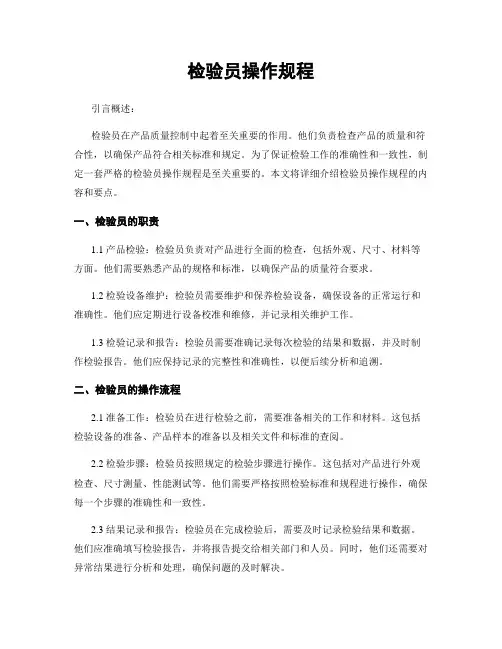
检验员操作规程引言概述:检验员在产品质量控制中起着至关重要的作用。
他们负责检查产品的质量和符合性,以确保产品符合相关标准和规定。
为了保证检验工作的准确性和一致性,制定一套严格的检验员操作规程是至关重要的。
本文将详细介绍检验员操作规程的内容和要点。
一、检验员的职责1.1 产品检验:检验员负责对产品进行全面的检查,包括外观、尺寸、材料等方面。
他们需要熟悉产品的规格和标准,以确保产品的质量符合要求。
1.2 检验设备维护:检验员需要维护和保养检验设备,确保设备的正常运行和准确性。
他们应定期进行设备校准和维修,并记录相关维护工作。
1.3 检验记录和报告:检验员需要准确记录每次检验的结果和数据,并及时制作检验报告。
他们应保持记录的完整性和准确性,以便后续分析和追溯。
二、检验员的操作流程2.1 准备工作:检验员在进行检验之前,需要准备相关的工作和材料。
这包括检验设备的准备、产品样本的准备以及相关文件和标准的查阅。
2.2 检验步骤:检验员按照规定的检验步骤进行操作。
这包括对产品进行外观检查、尺寸测量、性能测试等。
他们需要严格按照检验标准和规程进行操作,确保每一个步骤的准确性和一致性。
2.3 结果记录和报告:检验员在完成检验后,需要及时记录检验结果和数据。
他们应准确填写检验报告,并将报告提交给相关部门和人员。
同时,他们还需要对异常结果进行分析和处理,确保问题的及时解决。
三、检验员的技能要求3.1 专业知识:检验员需要具备相关产品和检验方法的专业知识。
他们应了解产品的特点和要求,掌握各种检验方法和技术。
3.2 视觉和触觉判断能力:检验员需要具备敏锐的观察力和判断力。
他们应能准确辨别产品的细微差别和缺陷,以确保产品的质量。
3.3 沟通和团队合作能力:检验员需要与其他部门和人员进行有效的沟通和协作。
他们应能清晰地传达检验结果和问题,并与相关人员共同解决质量问题。
四、检验员的工作环境和安全要求4.1 工作环境:检验员的工作环境应符合相关的安全和卫生要求。
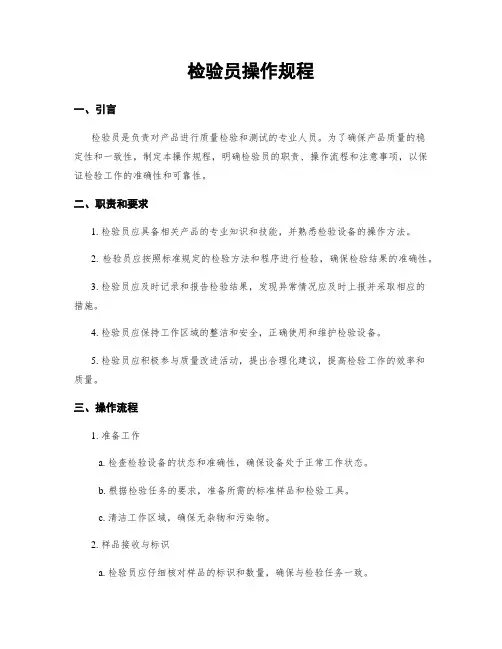
检验员操作规程一、引言检验员是负责对产品进行质量检验和测试的专业人员。
为了确保产品质量的稳定性和一致性,制定本操作规程,明确检验员的职责、操作流程和注意事项,以保证检验工作的准确性和可靠性。
二、职责和要求1. 检验员应具备相关产品的专业知识和技能,并熟悉检验设备的操作方法。
2. 检验员应按照标准规定的检验方法和程序进行检验,确保检验结果的准确性。
3. 检验员应及时记录和报告检验结果,发现异常情况应及时上报并采取相应的措施。
4. 检验员应保持工作区域的整洁和安全,正确使用和维护检验设备。
5. 检验员应积极参与质量改进活动,提出合理化建议,提高检验工作的效率和质量。
三、操作流程1. 准备工作a. 检查检验设备的状态和准确性,确保设备处于正常工作状态。
b. 根据检验任务的要求,准备所需的标准样品和检验工具。
c. 清洁工作区域,确保无杂物和污染物。
2. 样品接收与标识a. 检验员应仔细核对样品的标识和数量,确保与检验任务一致。
b. 对每个样品进行标识,包括样品编号、日期和检验员的姓名。
3. 检验操作a. 根据标准规定的检验方法和程序,进行检验操作。
b. 严格按照操作步骤进行,确保操作的准确性和一致性。
c. 在操作过程中,注意观察样品的状态和变化,并记录相关数据和观察结果。
4. 数据处理与记录a. 对检验结果进行数据处理和统计分析,确保结果的可靠性和准确性。
b. 将检验结果记录在检验报告中,包括样品编号、检验日期、检验员的姓名和检验结果。
c. 如发现异常情况或不合格品,应及时上报并采取相应的措施。
5. 设备维护与清洁a. 完成检验后,及时清洁和维护检验设备,确保设备的正常工作状态。
b. 对设备进行定期的校准和保养,确保设备的准确性和可靠性。
四、注意事项1. 检验员应遵守相关的安全操作规程,确保工作区域的安全和卫生。
2. 在进行检验操作前,应对检验方法和程序进行充分的了解和培训。
3. 检验员应保持良好的工作状态和专注力,避免疲劳和分心。
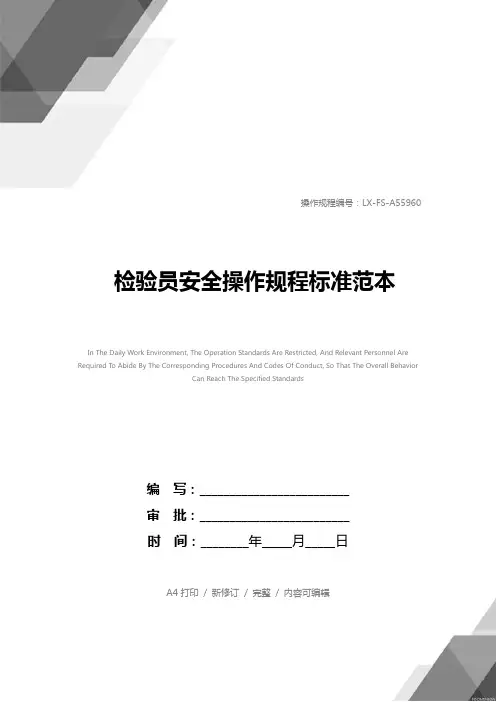
操作规程编号:LX-FS-A55960 检验员安全操作规程标准范本In The Daily Work Environment, The Operation Standards Are Restricted, And Relevant Personnel Are Required To Abide By The Corresponding Procedures And Codes Of Conduct, So That The Overall BehaviorCan Reach The Specified Standards编写:_________________________审批:_________________________时间:________年_____月_____日A4打印/ 新修订/ 完整/ 内容可编辑检验员安全操作规程标准范本使用说明:本操作规程资料适用于日常工作环境中对既定操作标准、规范进行约束,并要求相关人员共同遵守对应的办事规程与行动准则,使整体行为或活动达到或超越规定的标准。
资料内容可按真实状况进行条款调整,套用时请仔细阅读。
1、工作时检验室要注意通风,按规定穿戴劳动保护用品。
2、使用各种玻璃仪器要轻拿轻放,玻璃仪器有裂缝或缺损的不准使用,以防碰碎割伤手指。
3、烘箱、电炉等电器设备,湿手不准接触开关,以防触电;并指定专人负责,发现故障立即停止使用,通知电工及时修理;下班后必须切断电源,方可离开。
4、严格执行电烘箱安全操作规程。
5、正在工作的通电电炉、燃着的酒精灯要有专人看管,不得随意离开工作岗位。
6、酒精灯点燃时禁止添加酒精;酒精灯应用火柴点燃,严禁用酒精灯引火。
7、使用有毒害的化学品时,不要将头对着容器,防止化学品溅出造成伤害;各种有毒化学品,必须有专人管理,监督使用。
8、进入生产现场取样时,禁止靠近机械转动部位,女工要戴女工帽,不准穿高跟鞋;在阴暗潮湿部位行走要防绊防滑,必须注意自身安全,不可掉以轻心。
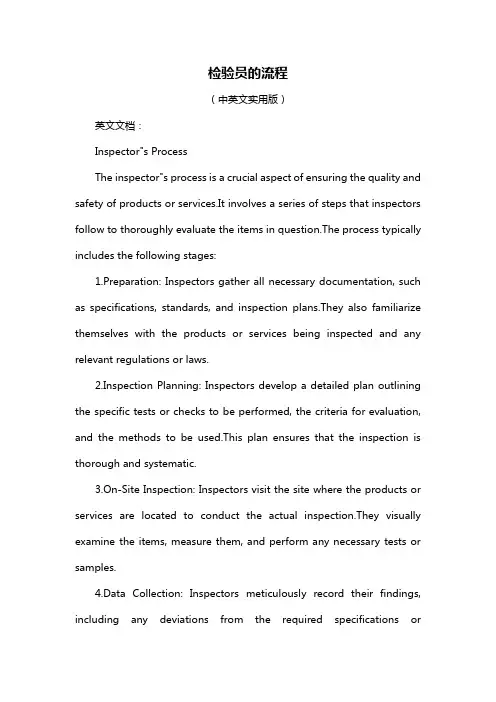
检验员的流程(中英文实用版)英文文档:Inspector"s ProcessThe inspector"s process is a crucial aspect of ensuring the quality and safety of products or services.It involves a series of steps that inspectors follow to thoroughly evaluate the items in question.The process typically includes the following stages:1.Preparation: Inspectors gather all necessary documentation, such as specifications, standards, and inspection plans.They also familiarize themselves with the products or services being inspected and any relevant regulations or laws.2.Inspection Planning: Inspectors develop a detailed plan outlining the specific tests or checks to be performed, the criteria for evaluation, and the methods to be used.This plan ensures that the inspection is thorough and systematic.3.On-Site Inspection: Inspectors visit the site where the products or services are located to conduct the actual inspection.They visually examine the items, measure them, and perform any necessary tests or samples.4.Data Collection: Inspectors meticulously record their findings, including any deviations from the required specifications orstandards.They document any issues or defects observed during the inspection.5.Analysis and Evaluation: Inspectors analyze the collected data to determine whether the products or services meet the required quality and safety standards.They compare the findings against the established criteria and make a judgment on the overall compliance.6.Reporting: Inspectors prepare a comprehensive report detailing their findings, analysis, and conclusions.This report is typically submitted to management or relevant stakeholders for further action or decision-making.7.Follow-Up: In cases where non-compliance is identified, inspectors may recommend corrective actions or improvements to address the issues.They may also conduct follow-up inspections to verify that the necessary corrective actions have been implemented effectively.The inspector"s process is essential for maintaining high standards of quality and safety in various industries, including manufacturing, healthcare, food production, and more.It helps ensure that products and services meet the expectations and requirements of customers and regulatory bodies.中文文档:检验员流程检验员的流程是确保产品或服务质量和安全的关键环节。
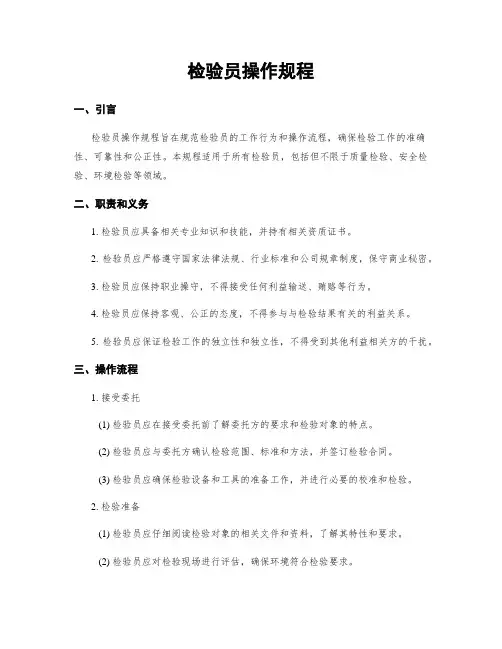
检验员操作规程一、引言检验员操作规程旨在规范检验员的工作行为和操作流程,确保检验工作的准确性、可靠性和公正性。
本规程适用于所有检验员,包括但不限于质量检验、安全检验、环境检验等领域。
二、职责和义务1. 检验员应具备相关专业知识和技能,并持有相关资质证书。
2. 检验员应严格遵守国家法律法规、行业标准和公司规章制度,保守商业秘密。
3. 检验员应保持职业操守,不得接受任何利益输送、贿赂等行为。
4. 检验员应保持客观、公正的态度,不得参与与检验结果有关的利益关系。
5. 检验员应保证检验工作的独立性和独立性,不得受到其他利益相关方的干扰。
三、操作流程1. 接受委托(1) 检验员应在接受委托前了解委托方的要求和检验对象的特点。
(2) 检验员应与委托方确认检验范围、标准和方法,并签订检验合同。
(3) 检验员应确保检验设备和工具的准备工作,并进行必要的校准和检验。
2. 检验准备(1) 检验员应仔细阅读检验对象的相关文件和资料,了解其特性和要求。
(2) 检验员应对检验现场进行评估,确保环境符合检验要求。
(3) 检验员应对检验设备和工具进行检查和调试,确保其正常运行。
3. 检验操作(1) 检验员应按照检验计划和方法进行操作,确保检验的全面性和准确性。
(2) 检验员应记录检验过程中的关键参数和结果,确保数据的真实性和可追溯性。
(3) 检验员应遵守操作规程和安全操作规范,确保人身安全和设备的正常运行。
4. 检验报告(1) 检验员应按照约定的时间提交检验报告,并确保报告的准确性和完整性。
(2) 检验报告应包括检验对象的基本信息、检验方法和标准、检验结果等内容。
(3) 检验报告应以客观、准确的方式呈现检验结果,并对结果进行解释和评估。
四、质量控制1. 检验员应参加公司组织的培训和考核,不断提升自身的专业水平和技能。
2. 检验员应定期检查和校准检验设备和工具,确保其准确性和可靠性。
3. 检验员应与其他检验员进行交流和合作,共同提高检验工作的质量和效率。
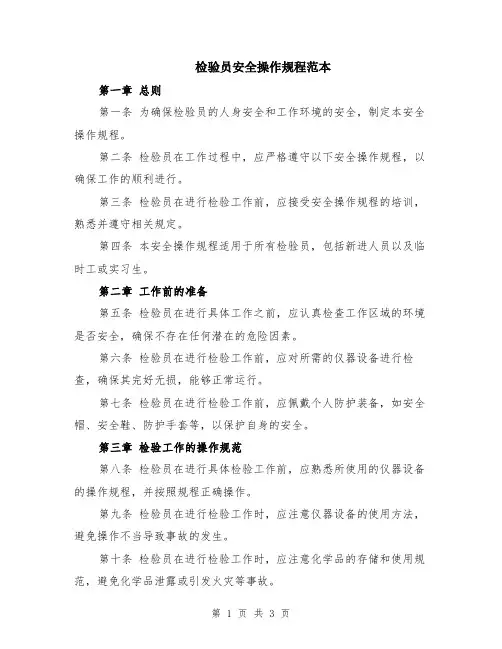
检验员安全操作规程范本第一章总则第一条为确保检验员的人身安全和工作环境的安全,制定本安全操作规程。
第二条检验员在工作过程中,应严格遵守以下安全操作规程,以确保工作的顺利进行。
第三条检验员在进行检验工作前,应接受安全操作规程的培训,熟悉并遵守相关规定。
第四条本安全操作规程适用于所有检验员,包括新进人员以及临时工或实习生。
第二章工作前的准备第五条检验员在进行具体工作之前,应认真检查工作区域的环境是否安全,确保不存在任何潜在的危险因素。
第六条检验员在进行检验工作前,应对所需的仪器设备进行检查,确保其完好无损,能够正常运行。
第七条检验员在进行检验工作前,应佩戴个人防护装备,如安全帽、安全鞋、防护手套等,以保护自身的安全。
第三章检验工作的操作规范第八条检验员在进行具体检验工作前,应熟悉所使用的仪器设备的操作规程,并按照规程正确操作。
第九条检验员在进行检验工作时,应注意仪器设备的使用方法,避免操作不当导致事故的发生。
第十条检验员在进行检验工作时,应注意化学品的存储和使用规范,避免化学品泄露或引发火灾等事故。
第十一条检验员在进行检验工作时,应按照程序和规定,进行样品的取样和处理,避免操作不当导致样品污染或损坏。
第四章突发情况的处置第十二条检验员在突发情况发生时,应立即采取必要的救护措施,并向上级报告,协助处理。
第十三条检验员在突发火灾时,应立即切断电源,采取相应的灭火措施,并向上级报告。
第十四条检验员在突发有害气体泄漏时,应迅速撤离现场,并根据实际情况进行必要的应急处理。
第十五条检验员在突发事故中受伤时,应立即寻求紧急救援,并按照规定及时报告,并接受相关处置和治疗。
第五章日常工作的安全注意事项第十六条检验员在日常工作中,应注意保持工作环境的整洁,避免人员和物品的混乱,防止事故的发生。
第十七条检验员在日常工作中,应严禁随意移动或调整仪器设备,如确需操作,应经过相关许可,并且在安全的操作环境下进行。
第十八条检验员在日常工作中,应定期检查和维护使用的仪器设备,确保其正常运行和安全使用。
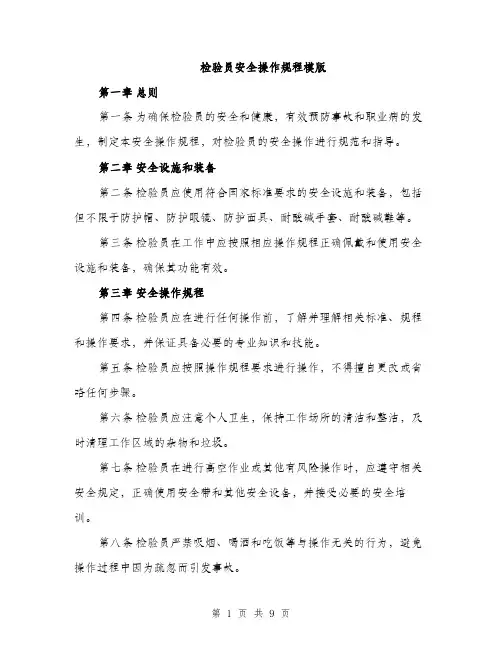
检验员安全操作规程模版第一章总则第一条为确保检验员的安全和健康,有效预防事故和职业病的发生,制定本安全操作规程,对检验员的安全操作进行规范和指导。
第二章安全设施和装备第二条检验员应使用符合国家标准要求的安全设施和装备,包括但不限于防护帽、防护眼镜、防护面具、耐酸碱手套、耐酸碱鞋等。
第三条检验员在工作中应按照相应操作规程正确佩戴和使用安全设施和装备,确保其功能有效。
第三章安全操作规程第四条检验员应在进行任何操作前,了解并理解相关标准、规程和操作要求,并保证具备必要的专业知识和技能。
第五条检验员应按照操作规程要求进行操作,不得擅自更改或省略任何步骤。
第六条检验员应注意个人卫生,保持工作场所的清洁和整洁,及时清理工作区域的杂物和垃圾。
第七条检验员在进行高空作业或其他有风险操作时,应遵守相关安全规定,正确使用安全带和其他安全设备,并接受必要的安全培训。
第八条检验员严禁吸烟、喝酒和吃饭等与操作无关的行为,避免操作过程中因为疏忽而引发事故。
第九条检验员在操作过程中应保持专注,不得与他人闲聊、玩手机或进行任何分散注意力的行为。
第十条检验员应密切关注仪器设备的使用状况,如发现异常应及时报告维修人员或主管,并在维修前停止使用。
第十一条检验员应定期对自己的安全操作进行评估和检查,对发现的问题及时进行整改。
第四章应急处理第十二条检验员在操作过程中如发生事故或异常情况,应立即采取应急措施,保障自己和他人的安全。
第十三条检验员在发生火灾或爆炸等危险情况时,应按照预先制定的应急预案进行疏散和救护,确保人员的生命安全。
第十四条检验员在进行危险化学品操作时应注意防止泄漏和污染,如发生泄漏应按照相应措施进行紧急处理。
第五章禁止操作事项第十五条检验员严禁进行未经授权或超出自己技能范围的操作,不得进行不安全的操作。
第十六条检验员不得随意更改操作规程或操作方法,如有需要应提出修改建议,并经过批准后方可执行。
第十七条检验员不得在无人陪同或未经授权的情况下进行高风险操作,如有需要应查明情况并取得相应的许可。
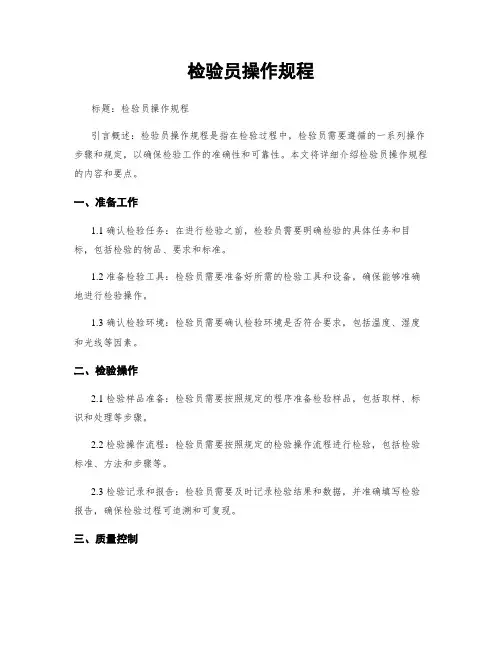
检验员操作规程标题:检验员操作规程引言概述:检验员操作规程是指在检验过程中,检验员需要遵循的一系列操作步骤和规定,以确保检验工作的准确性和可靠性。
本文将详细介绍检验员操作规程的内容和要点。
一、准备工作1.1 确认检验任务:在进行检验之前,检验员需要明确检验的具体任务和目标,包括检验的物品、要求和标准。
1.2 准备检验工具:检验员需要准备好所需的检验工具和设备,确保能够准确地进行检验操作。
1.3 确认检验环境:检验员需要确认检验环境是否符合要求,包括温度、湿度和光线等因素。
二、检验操作2.1 检验样品准备:检验员需要按照规定的程序准备检验样品,包括取样、标识和处理等步骤。
2.2 检验操作流程:检验员需要按照规定的检验操作流程进行检验,包括检验标准、方法和步骤等。
2.3 检验记录和报告:检验员需要及时记录检验结果和数据,并准确填写检验报告,确保检验过程可追溯和可复现。
三、质量控制3.1 校准检验工具:检验员需要定期对检验工具进行校准和验证,确保检验结果的准确性和可靠性。
3.2 质量把关:检验员需要在检验过程中进行质量把关,确保检验操作符合规范和标准。
3.3 处理异常情况:检验员需要及时处理检验中浮现的异常情况,包括设备故障、样品损坏和数据错误等。
四、安全与环保4.1 安全操作规范:检验员需要严格遵守安全操作规范,包括佩戴防护装备、避免操作失误和注意事故预防等。
4.2 环境保护意识:检验员需要具备环境保护意识,遵守环保规定,减少废物排放和资源浪费。
4.3 应急处理措施:检验员需要熟悉应急处理措施,能够在紧急情况下迅速做出反应和处理。
五、持续改进5.1 反馈和总结:检验员需要接受检验结果的反馈和总结,及时调整和改进检验操作,提高检验工作的质量和效率。
5.2 学习和培训:检验员需要不断学习和提升自身的专业知识和技能,参加相关培训和学习活动。
5.3 制定改进计划:检验员需要制定改进计划,定期评估和调整检验操作规程,以适应不断变化的检验需求和标准。
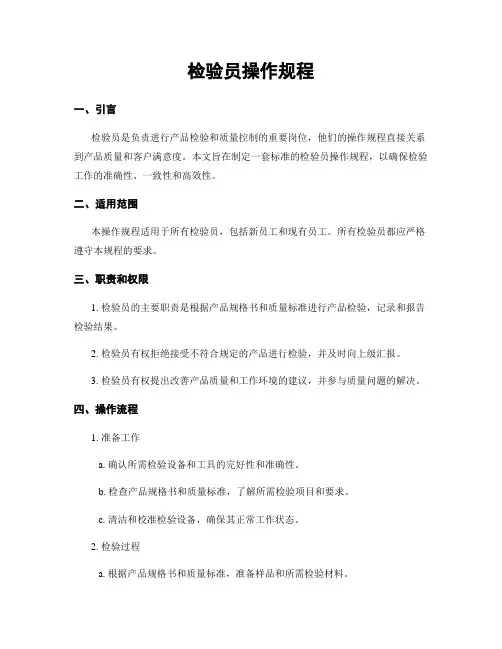
检验员操作规程一、引言检验员是负责进行产品检验和质量控制的重要岗位,他们的操作规程直接关系到产品质量和客户满意度。
本文旨在制定一套标准的检验员操作规程,以确保检验工作的准确性、一致性和高效性。
二、适用范围本操作规程适用于所有检验员,包括新员工和现有员工。
所有检验员都应严格遵守本规程的要求。
三、职责和权限1. 检验员的主要职责是根据产品规格书和质量标准进行产品检验,记录和报告检验结果。
2. 检验员有权拒绝接受不符合规定的产品进行检验,并及时向上级汇报。
3. 检验员有权提出改善产品质量和工作环境的建议,并参与质量问题的解决。
四、操作流程1. 准备工作a. 确认所需检验设备和工具的完好性和准确性。
b. 检查产品规格书和质量标准,了解所需检验项目和要求。
c. 清洁和校准检验设备,确保其正常工作状态。
2. 检验过程a. 根据产品规格书和质量标准,准备样品和所需检验材料。
b. 检查样品的标识和完整性,确保其与产品规格书一致。
c. 按照规定的方法和顺序进行检验,确保准确性和一致性。
d. 记录检验结果,包括合格和不合格项,并标注相关细节和数据。
e. 如发现不合格项,立即停止检验,并及时向上级报告。
3. 数据处理和报告a. 检验员应对检验结果进行统计和分析,以便评估产品质量和检验效果。
b. 检验员应及时编制检验报告,并按照规定的方式和渠道提交给相关部门或客户。
c. 如发现重大质量问题,检验员应立即上报,并参与问题的解决和改进。
五、安全与环境保护1. 检验员在进行检验工作时,应遵守公司的安全操作规程,确保自身和他人的安全。
2. 检验员应妥善处理废弃物和污染物,按照公司的环境保护要求进行处理和处置。
六、培训和考核1. 公司应定期组织检验员培训,包括产品知识、检验方法和操作规程等方面的培训。
2. 检验员应参加培训并通过考核,以确保其具备进行检验工作所需的知识和技能。
七、变更和修订1. 如有必要对本操作规程进行变更和修订,应经过相关部门的审核和批准。
检验员操作规程一、引言检验员操作规程是为了确保检验工作的准确性、可靠性和一致性,规范检验员的操作行为,提高检验工作的质量和效率。
本操作规程适用于所有检验员,包括新员工和有经验的员工。
二、检验员的职责和权利1. 检验员应熟悉所检验产品的相关知识和技术要求,了解检验方法和流程。
2. 检验员应按照规定的时间和要求完成检验任务,并及时报告检验结果。
3. 检验员应保证检验过程的准确性和可靠性,严禁随意修改或篡改检验数据。
4. 检验员有权要求提供所需的检验设备、工具和资料。
5. 检验员有权向上级主管报告工作中的问题和困难,并提出改进建议。
三、检验员的操作流程1. 准备工作a. 检验员应熟悉所检验产品的技术要求和规范。
b. 检验员应检查所使用的检验设备和工具是否正常,并进行必要的校准和维护。
c. 检验员应清洁工作区域,确保无杂物和污染。
2. 检验前的准备a. 检验员应确认待检验产品的标识和数量是否正确。
b. 检验员应检查待检验产品的外观是否符合要求。
3. 检验过程a. 检验员应按照检验方法进行检验,并记录检验结果。
b. 检验员应注意检验过程中的细节和注意事项,确保操作的准确性。
c. 检验员应及时处理发现的不合格品,并按照规定进行记录和处理。
4. 检验后的处理a. 检验员应整理和归档检验记录和相关文件。
b. 检验员应向上级主管报告检验结果和问题。
四、检验员的操作注意事项1. 检验员应遵守相关的安全操作规程,确保自身和他人的安全。
2. 检验员应保持良好的工作状态,避免疲劳和精神不集中。
3. 检验员应遵守工作纪律,不得私自离岗或擅自更改检验记录。
4. 检验员应保护和维护检验设备和工具,确保其正常运行。
5. 检验员应随时更新自己的专业知识和技能,提高自身的工作能力。
五、检验员的培训和评估1. 公司应对新员工进行相关的培训,包括产品知识、检验方法和操作规程等。
2. 公司应定期对检验员进行技术培训和知识更新,确保其具备适应工作需要的能力。
sgs认证公司员工手册范本以下是一份SGS认证公司员工手册范本,供您参考:SGS认证公司员工手册欢迎加入SGS认证公司大家庭!SGS认证公司是一家全球领先的检验、鉴定、测试和认证服务提供商。
自xxxx年成立以来,我们一直致力于为全球客户提供卓越的服务。
作为SGS 认证公司的一员,我们期待您能充分发挥自己的潜能,与公司共同成长。
本手册旨在帮助您更好地了解公司文化、规章制度以及工作职责等方面的信息。
请仔细阅读并遵守本手册中的规定和要求。
如有任何疑问或建议,请及时与人力资源部门联系。
第一章:公司文化SGS认证公司秉持专业、诚信、公正和可靠的原则,致力于为客户提供高质量的服务。
我们重视团队合作,鼓励员工互相学习、共同进步。
同时,我们也鼓励员工发挥个人特长,为公司的发展贡献自己的力量。
第二章:规章制度1.工作时间:公司实行标准工作时间制度,员工应按时上下班,不得无故迟到早退。
2.休假制度:公司将按照国家法律法规和公司规定安排员工休假。
员工请假需提前向直属上级请假并填写请假单。
3.保密制度:所有员工必须严格遵守保密规定,保护公司的商业机密和客户信息。
4.行为规范:员工应保持良好的职业操守,不得从事任何违法违纪行为。
第三章:工作职责与要求1.工作任务:您将根据所在部门和岗位的不同,承担相应的工作任务。
请按时完成工作任务,并保证工作质量。
2.工作要求:您需要具备高度的责任心和团队合作精神,积极主动地完成工作任务。
同时,您也需要不断学习和提升自己的专业技能和知识水平。
第四章:培训与发展公司将为员工提供各种培训和发展机会,帮助员工提升专业技能和知识水平。
同时,公司也鼓励员工积极参加内外部培训和学习活动,以提升自身竞争力。
检验员操作规程一、引言本操作规程旨在规范检验员的操作行为,确保检验工作的准确性和可靠性。
本规程适用于所有检验员,包括新员工和有经验的员工。
二、检验员的职责和权责1. 检验员应熟悉相关的检验标准、规程和操作流程,并按照要求进行操作。
2. 检验员应具备良好的观察力和判断力,能够准确识别和记录测试结果。
3. 检验员应保证测试设备的准确性和可靠性,及时进行校准和维护。
4. 检验员应及时向上级报告测试结果和异常情况,并采取必要的措施进行纠正。
5. 检验员应保护和维护检验设备和样品的完整性,确保其安全和可靠性。
三、操作规程1. 准备工作a. 检查测试设备的状态和准确性,确保设备已经校准并符合要求。
b. 检查样品的标识和完整性,确保样品没有损坏或被污染。
c. 准备好所需的测试方法、标准和记录表格。
2. 检验操作a. 按照测试方法和标准进行检验操作,确保操作的准确性和一致性。
b. 严格按照操作流程进行操作,不得随意修改或省略步骤。
c. 注意观察测试过程中的任何异常情况,并及时记录和报告。
d. 注意测试结果的准确性和可靠性,避免人为误差的产生。
3. 数据记录与报告a. 准确记录测试结果和相关数据,包括样品信息、测试数值和观察结果等。
b. 确保记录的完整性和可追溯性,包括日期、时间、检验员等必要信息。
c. 检查记录表格的正确性和规范性,确保数据的可读性和可理解性。
d. 按照要求编制检验报告,并及时提交给相关部门或客户。
四、安全与环境保护1. 检验员应遵守相关的安全操作规程和环境保护要求,确保工作场所的安全和卫生。
2. 检验员应正确使用个人防护装备,如手套、口罩和安全眼镜等。
3. 检验员应妥善处理和处置产生的废弃物和污染物,确保环境的健康和安全。
五、培训与评估1. 公司应定期组织检验员的培训和考核,提升其技能和知识水平。
2. 检验员应参加培训并通过考核,确保其了解和掌握最新的操作规程和要求。
3. 公司应定期对检验员的工作进行评估和监督,确保其符合操作规程和要求。
检身工操作规程范文检身工操作规程一、检身工的基本要求1. 严格遵守工作纪律,服从上级的指挥和调度。
2. 具备良好的职业道德和职业素养,对于工作中的机密信息保密。
3. 具备良好的身体素质和健康状况,能够适应长时间站立和体力劳动。
4. 具有一定的心理承受能力,能够面对工作中的压力和困难。
5. 具备良好的沟通能力和团队合作精神。
二、工作准备1. 每天工作前先进行身体检查,确保身体状况良好。
2. 穿着整齐干净、符合安全要求的工作服。
3. 携带必要的工具和设备,如手套、口罩、尺子等。
三、工作流程1. 根据工作安排和指示,准时到达工作岗位。
2. 负责对入厂人员进行安全检查,确保他们符合入厂条件。
3. 对入厂人员进行身体测量,如身高、体重等数据的收集。
4. 检查入厂人员的正常体温,如超过正常范围需及时报告主管。
5. 对入厂人员进行布料检查,确保不会带入禁止携带的物品。
6. 如发现入厂人员有异常情况,如伤病、昏迷等,应立即通知主管并寻求救助。
7. 如发现入厂人员携带违禁物品,应立即上报主管处理。
8. 如遇突发情况,如火灾、地震等,应按照应急预案进行处理。
9. 工作结束时,清理工作现场,保持工作区域的整洁。
四、注意事项1. 工作中需要保持专注,认真仔细进行检查,不可敷衍塞责。
2. 不得私自外借或泄露单位的工作设备和工作信息。
3. 不得擅自将入厂人员的个人信息透露给他人,以保护其隐私权。
4. 如遇工作中的问题或困难,应及时向主管汇报并寻求解决办法。
5. 不得私自接受入厂人员的贿赂或收受其他非法利益。
6. 工作期间必须严格按照安全操作规程进行操作,确保自身和他人的安全。
7. 不得将工作中的责任和任务怠慢或推诿,需全力以赴完成工作。
以上是检身工操作规程的范文,希望对您有所帮助!。
检验员操作规程一、引言检验员操作规程旨在规范检验员在工作中的操作流程和行为准则,确保检验工作的准确性和可靠性。
本操作规程适用于所有检验员,在进行各类检验任务时必须遵守。
二、职责和权限1. 检验员的主要职责是根据检验要求,对产品、设备、材料等进行检验,并根据检验结果提出评价和建议。
2. 检验员应具备相关的专业知识和技能,熟悉检验方法和流程,能够正确操作检验设备和工具。
3. 检验员有权要求被检验对象提供必要的信息和样品,并有权拒绝进行未经授权的检验工作。
三、操作流程1. 接收任务检验员应及时接收来自上级或委托方的检验任务,并了解任务的具体要求和时间安排。
2. 准备工作在进行检验之前,检验员应进行以下准备工作:- 确认检验所需的设备、工具和试剂是否齐全,并进行必要的校准和检验。
- 确认检验环境是否符合要求,如温度、湿度等。
- 准备检验记录表格和相关文件。
3. 样品接收与标识- 检验员应准确记录样品的来源、数量和状态,并进行标识,以防止混淆。
- 如有需要,可以对样品进行必要的预处理,如分割、研磨等。
4. 检验操作- 检验员应按照检验方法和要求进行检验操作,确保操作的准确性和可重复性。
- 在进行检验操作时,应注意安全事项,如佩戴个人防护装备、遵守操作规程等。
- 如发现异常情况或设备故障,应及时报告并采取相应的措施。
5. 数据处理与记录- 检验员应准确记录检验的过程和结果,包括检验方法、操作步骤、观察结果、测量数据等。
- 如有需要,可以进行数据处理和分析,并提出相应的评价和建议。
- 检验记录应按照规定的格式和要求填写,并确保记录的完整性和可追溯性。
6. 报告编制与提交- 检验员应根据检验结果编制检验报告,并确保报告的准确性和清晰度。
- 检验报告应包括样品信息、检验结果、评价和建议等内容,并按照要求进行签名和盖章。
- 检验报告应及时提交给上级或委托方,并保留相关的备份和记录。
四、行为准则1. 诚信守规检验员应遵守职业道德和行为准则,保持诚信和专业素养,不得参与任何违法违规的活动。